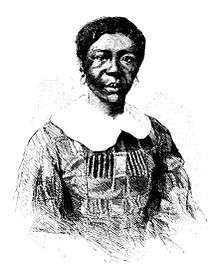Harriet Robinson Scott
Harriet Robinson Scott (c. 1815 – June 17, 1876) was an African American slave who, despite adversity, fought for her freedom alongside her husband Dred Scott in the popular court case Scott v Sanford. After she and her husband were manumitted in 1857, she lived the rest of her life as a laundress.
Harriet Robinson Scott | |
|---|---|
 Scott c. 1857 | |
| Born | c. 1815 |
| Died | June 17, 1876 (aged c. 61) |
| Resting place | Greenwood Cemetery |
| Nationality | American |
| Known for | Dred Scott v. Sandford |
| Spouse(s) | |
| Children | 2 daughters |
Early life
Harriet Robinson Scott was born around 1815 as a slave on a Virginia plantation. She was owned by Lawrence Taliaferro, a federal Indian agent.[1] In 1835, Taliaferro was assigned to Fort Snelling, a military post and fur-trading outpost; he required Harriet to accompany him and do housework for his wife and him, even though slavery was technically prohibited in this new territory under the Missouri Compromise. Many men in military service disregarded the Compromise as they were transferred between federal territories which variously allowed or prohibited slaveholding.[1]
Time at Fort Snelling
Harriet lived among and worked alongside other slaves during her time at Fort Snelling along with interacting with Native Americans from various tribes. While at Fort Snelling she met her future husband, Dred Scott. Dred Scott was a personal slave to Dr. John Emerson who was a military surgeon.[1]
Marriage
Harriet married Dred Scott in 1836 when she was at the age of 21 and he was 36. They were married by Lawrence Taliaferro and Harriet became the property of Emerson in result. In those days, it was customary for slaves to be joined as a couple by jumping the broom. Harriet, however, insisted on a wedding and persuaded Major Taliaferro, who was also a justice of the peace, to perform the ceremony. Harriet believed deeply in the strength of the family bond, and wanted this official ceremony to mark the start of her own family. Many historians believe this marriage gave additional credence to the Scotts' claim to freedom.[2]
Two years after the two were married, Harriet became pregnant with their first child. Despite her pregnancy, she and her husband moved to Fort Jesup, Louisiana on behalf of Emerson and his wife who wanted the couple to make the trip and continue to work for them. Harriet gave birth on a steamer in St. Louis to a daughter, who she named Eliza. Two years following, she gave birth to another child named Lizzie.[1][3]
The Case
Dr. Emerson passed away in 1843 and Harriet and Dred and their children were left to Irene Emerson, John Emerson's widow. They continued to work in St. Louis while Irene collected their pay until 1846 when they began the attempt to gain their freedom from Irene in court. Both Harriet and Dred filed their own petitions as they relied on their lawyer, Francis Murdock, and the minister of the African Baptist church they attended, John R. Anderson, due to illiteracy. Due to Harriet's time at Fort Snelling, a free state, she was aware that she had a good chance at having her freedom granted, like many others, after taking her petition to court. Irene found a way to keep the Scott family under custody of the St. Louis country sheriff for seven years while she continued to collect their working pay. The Scott family was granted their freedom on January 12, 1850 until Irene appealed their case and the court combined Harriet's and Dred's petitions into one, creating the case Dred Scott vs. Irene Emerson which included Harriet and her children with Dred. Five years later on March 6, 1857, after the Dred Scott v. Sandford case was moved through to the US Supreme Court, the court had decided the Scott family should remain slaves. This only lasted two months before the Scotts became property of Taylor Blow who then freed them immediately.[1]
Life after freedom
Shortly after gaining freedom, Harriet's husband died of Tuberculosis.[3] Harriet continued to live free, working as a laundress, and owning her own home until she died on June 17, 1876 when she was 61 years old.[1]
References
- "Harriet Robinson Scott - Historic Missourians - The State Historical Society of Missouri". shsmo.org. Retrieved 2016-11-10.
- "Harriets Story". www.thedredscottfoundation.org. Retrieved 2020-06-30.
- "Dred Scott Case, 1846–1857". Missouri Digital Heritage. Retrieved 2015-07-16.
Further reading
- William D. Green (2007). A Peculiar Imbalance: The Fall and Rise of Racial Equality in Early Minnesota. Minnesota Historical Society. ISBN 9780873515863.